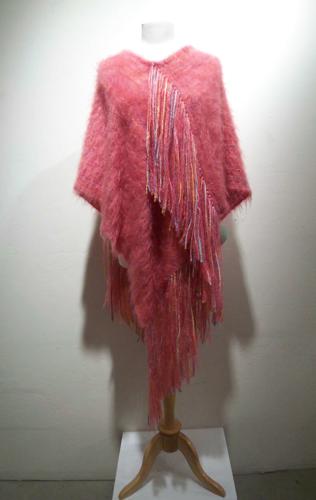Master weaver Crane Day died Friday of as-yet-undetermined causes. He fell two weeks ago and was at St. Mary’s Hospital, where he was recovering from hip surgery. He was 81.
On Saturday, a small group of fellow artists gathered in Day’s studio. It is meticulously organized and packed with colorful yarns, flowing ponchos and exquisite shawls. Three-ring binders full of details and photos of his work are in a loaded bookcase. Tapestries hang on the wall. Carefully laid over one of the several looms is a shawl, a piece he had just completed.
“He didn’t leave anything on the loom,” said Kami Boufelfel with a bit of awe.
Boufelfel has been working beside Day, apprenticing with him for three years.
She pointed out a flaw Day had brought to her attention in the last piece he wove.
“He called this his spirit trail,” she said, tracing it with her finger.
Day’s work brought him international attention. He won awards and his work is in collections around the country. Aretha Franklin wore one of his creations. So did dancer Ann Miller. The pope was presented with a Day-created alb, a religious garment, woven of cream-colored silk with crosses on the sleeves.
Boufelfel, Robert Redding, who also apprenticed with Day, and Kathryn Wilde sat around the table where Day would often sit and greet visitors.
“I can’t believe it,” said Wilde of Day’s death. She had had a studio next to his for 18 years.
“He was a one-of-a-kind friend in life. He was so gentle. I’m going to really miss him,” Wilde said.
Boufelfel and Redding agreed.
“He was very giving and generous,” said Boufelfel.
“I learned the process (of weaving) from a purist,” added Redding.
“Mentors can be so imposing and I never felt that from him. He was a very gentle mentor.”
Day was born in Pawhuska, Oklahoma. He was of French and Osage descent, and grew up on the Osage Reservation near Pawhuska.
He studied anthropology and sociology at the University of Notre Dame and went to graduate school at Michigan State University for a master’s in interior design.
It was there that he discovered his passion. He was required to take a course in weaving so that he could understand fabrics.
“My professor said I kicked and screamed all the way into the room,” Day recalled in a 2011 interview with the Star.
“But I just remember going in, sitting down at the loom and feeling totally in control of my universe in a way that I never had before.”
Day moved to Tucson in 1969 to teach at the University of Arizona. He eventually left to study in France and travel, but the road always led him back to the Old Pueblo.
In 1990, he moved here permanently and set up his studio.
“He did masterful work, so classic, so magnificent,” said jewelry artist Rubina Gallo, who has had a studio in the same building as Day for 18 years.
“It is timeless. It’s not a fad or a style. You could wear it forever.”
While Day was focused and passionate about his weaving, he was equally focused and passionate about his friends.
He loved to cook and gather people at his home. It was there that friends discovered something that was indicative of just how thoughtful Day was.
“He had a prayer chapel in his home with the most beautiful artifacts he had collected,” said Gallo.
“He used to do prayer tents, pieces of white paper, and he would write (in calligraphy) on them the name of who he was praying for. He always had candles going. He was so soulful. ... He was one of the kindest spirits I’ve ever known.”
“It’s a huge loss for the community,” said Pam Shack, who studied with Day in the early 1970s. He was “overwhelmingly generous, outgoing, giving.”
Day is survived by two nephews, Justin and Rusty Day of Colorado.
At his request, no services are planned.







